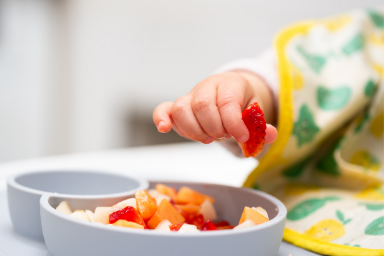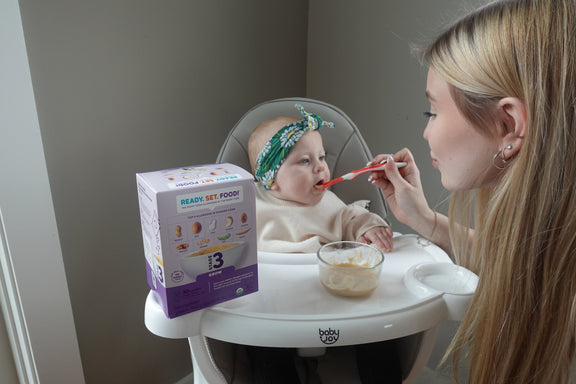You’ll probably need to spoon feed baby at some point – even if you’re primarily doing baby-led weaning. Spoon feeding baby the right way will help them develop healthy eating habits that stick for the rest of their lives. Learn the best ways to spoon feed – and the mistakes to avoid – with our list of dos and don’ts.
At Ready. Set. Food!, we’re here to support you as you introduce solids to your little one – whichever way you choose.
Whether you’ve decided to start baby-led weaning, you’re beginning baby’s food journey with purees, or you’re giving them a combination of both, you’ll likely need to spoon feed your baby eventually. After all, there’s plenty of yummy foods out there (like yogurt and oatmeal) that baby will need a spoon to enjoy.
Spoon feeding baby the right way will help baby build up mouth and tongue control, learn how to tell when they are hungry and when they are full, and develop healthy eating habits that stick for the rest of their lives. Today, you’ll learn the best ways to spoon feed – and the mistakes to avoid – with our list of dos and don’ts.
The Dos: Essential Spoon Feeding Tips
Follow this list of tips when spoon feeding your little one:
- Do wait until baby is ready for solids.
- Do choose the right feeding position.
- Do use a baby-friendly spoon.
- Do model eating from a spoon.
- Do watch for hunger cues.
- Do give time for baby to respond to the spoon.
- Do let baby take the food at their own pace.
- Do give baby time to play with the spoon.
- Do try the 2-spoon trick if baby wants to hold the spoon during a feed.
For more spoon feeding tips and tricks, check out this “dos and don’ts” video from occupational therapist Emma Hubbard:
Do wait until baby is ready for solids.
To eat any solids, including solids using a spoon, baby must be developmentally ready. They must be able to sit up with little to no support, and have good head control. They should show interest in the food you’re eating (by opening their mouth or even reaching for it).
Most importantly, your baby must not have the tongue-thrusting reflex anymore. If baby has lost the tongue-thrusting reflex, they’ll be able to hold food in their mouth and swallow, and their tongue won’t force it out.
When baby is ready for solids, start their first foods exploration with purees that are smooth in texture.
Do choose the right feeding position.
Baby needs to be upright and well-supported when you feed them. Make sure they are in a high chair or strap-in booster seat with lots of support at the back. If they don’t have to worry about supporting themself, they can focus on the process of eating.
Do use a baby-friendly spoon.
Picking the best type of spoon for baby will help them remove food from it more easily. You’ll want a spoon with a “bowl” (food-holding area) that’s either shallow or flat, so it holds smaller amounts of food at a time. The “bowl” should also be narrow, so it fits in baby’s small mouth. It should cover most of the tongue, but not the edges of the tongue, when it is in baby’s mouth.
There are plenty of spoons out there for baby, but any spoon with a silicone or BPA-free plastic “bowl” will do. Avoid metal spoons – even the small toddler ones are only for children 18 months old and older.
Do model eating from a spoon.
Using a puree-filled spoon, show your little one how you open your mouth wide. Then, close your mouth on the spoon, really emphasizing that close, so baby can see how you close your mouth around the spoon. Sometimes, babies need to see you close your mouth like this to realize that’s how they get food off the spoon.
Do watch for hunger cues.
Baby might not accept the spoon willingly if they aren’t hungry. Don’t enter this power struggle – wait until they’re ready to eat.
Baby is ready for you to put the spoon in their mouth if they show any of these hunger cues:
- Opens their mouth when you offer the food
- Clenches their fists
- Sucks on their hands or moves hands towards the mouth
- Smacks their lips
- Turns their head towards the food or spoon and keeps their eye on it,
- Reaches out for food or the spoon
- Seems visibly happy when food is offered
Do give time for baby to respond to the spoon.
Once baby seems ready, put a little food on the spoon and hold the spoon up to baby’s lips. Let them smell the food and see if they open their mouth to accept the spoon. If they do, put the spoon in their mouth slowly.
This gives baby control of when to eat – it’s important that they have that control and learn to recognize when they’re hungry and when they’re full.
Do let baby take the food at their own pace.
Once the spoon is in their mouth, let baby close their upper lip around the spoon, and then suck the food. As they suck the food, slowly move the spoon out of baby’s mouth, keeping it straight. This way, baby can remove the food from the spoon on their own – you aren’t scraping it off for them. Then, give them time to swallow (this will take a few seconds at first).
Going slowly will give baby time to notice if they’re still hungry, or if they feel full. Repeat the spoon feeding process for as long as baby is still hungry, but end the feed if they show signs of fullness.
Do give baby time to play with the spoon.
After a feed, it helps to give baby a spoon to hold so they can explore it. They might bring it to their mouth and teethe, or they might just play with it. Either way, this helps build fine motor skills that will eventually lead up to self-feeding with the spoon.
When can your little one start to self-feed with the spoon? Usually, not until around 10-12 months of age. Learn more in our article on giving baby the spoon.
Do try the 2-spoon trick if baby wants to hold the spoon during a feed.
Is baby constantly trying to grab at the spoon during the feed? They may want to try to feed themself. That’s a good thing! But if they’re just starting out or are under 9 months of age, they probably don’t have all the motor skills needed to feed themself. That’s ok too!
Try using two spoons at mealtime. Put just a little bit of puree on one, then give that one to baby and let baby try to self-feed. Then fill the other one as normal, and spoon feed baby in between their bite attempts. Yes, this will get messy, but embrace this because baby’s working towards independent feeding. You can clean baby off once mealtime is over.
The Don'ts: Spoon Feeding Mistakes To Avoid
When you’re spoon feeding baby, this list of don’ts will help you know what mistakes to avoid:
- Don’t feed baby when there are distractions around.
- Don’t spoonfeed baby if they’re reclined or unsupported.
- Don’t force it if baby doesn’t want to continue eating.
- Don’t overload the spoon.
- Don’t panic if baby gags.
- Don’t try to take control of the feed.
- Don’t give up on certain foods if baby refuses them.
- Don’t stick to just smooth textures on the spoon.
Don’t feed baby when there are distractions around.
If baby is distracted by toys, the tablet, or the TV, they won’t fully focus on the process of eating and the taste of the food. Plus, it’s important for you and baby to interact with each other during the feed, so you can pick up on their hunger and fullness cues. Save the distractions for another time – during mealtime, talk to baby and interact with them.
Don’t spoon feed baby if they’re reclined or unsupported.
It’s unsafe to feed baby if they’re in a car seat, stroller, or other reclined position. This puts them at risk for choking.
You also shouldn’t spoon feed baby if they’re on your lap, because they don’t have enough back support in that position. Similarly, avoid seats and seated positions with little to no back support.
Don’t force it if baby doesn’t want to continue eating.
Don’t start to spoon feed if baby is showing signs of fullness. It’s important that they eat when they’re hungry, and aren’t forced to eat if they’re full or their body isn’t ready.
When you hold the spoon up to their lips, if baby closes their mouth, turns away, pushes the spoon away, gets fussy, or tries to block it from going in their mouth, stop and try again later. Don’t try to push baby to eat.
And if you’ve successfully started a spoon feed and baby takes some bites, but then starts to show those signs of fullness, that’s your cue to stop feeding them. It doesn’t matter if there’s food left in the jar or bowl – when they’re full, that’s the end of the mealtime.
Don’t overload the spoon.
When they’re ready, start by feeding baby a spoon with just a little food on the front. After they’ve taken this, gradually add more food to the spoonful until you’re giving baby just-full spoons. But don’t pile food on top of the spoon. Too much food can be overwhelming to a baby who has just started solids. Feeding too much food at once can trigger baby’s gag reflex.
Don’t panic if baby gags.
If baby does gag, don’t worry. Gagging is a perfectly normal reflex that helps protect your baby from choking. If they gag, their body is doing what it’s supposed to if too much food is in their mouth at once. Let baby work the gag out on their own.
Gagging is very different from the very dangerous choking. Gagging is loud but choking is silent. Learn more about the differences between gagging and choking in our previous article.
Don’t try to take control of the feed.
It may be tempting to open baby’s mouth for them, or to try to quickly sneak food in their mouth. But this takes control away from baby. It’s much better to let baby move through each step of the spoon feeding at their own pace, so they learn how to handle food. And like we mentioned earlier, it helps baby tell when they’re hungry and when they’re full.
You also shouldn’t wipe the food off of baby’s lip or off the roof of their mouth, as baby needs to learn how to suck that food off themself when they are ready. And don’t scrape the puree off the spoon! They need to use their mouth muscles and tongue to remove the food, and scraping it off takes that opportunity away.
Don’t pour the food into baby’s mouth, either. Just offer it on the spoon and let baby suck it at their own pace.
And don’t stop baby from grabbing the spoon. Like we mentioned above, that’s a sign that baby wants to feed themself.
Don’t give up on certain foods if baby refuses them.
If baby isn’t interested in a certain food, or starts to refuse it after just a bite, you shouldn’t force them to continue with the feed. But remember that babies sometimes need 15 or more exposures to a food to start eating it regularly. They might still be getting used to the flavor, texture, or smell. So, don’t give up on that food completely. Offer the food at a different time and see how they respond.
Don’t stick to just smooth textures on the spoon.
Once your baby has mastered smooth purees, it’s important that you introduce them to baby-safe foods with thicker and chunkier textures. Introducing your little one to a variety of healthy foods, with different flavors and textures, helps them maintain a diverse, nutritious diet in the years to come. It also gives them more practice with munching and chewing, and more confidence with different foods – after all, chewing is a skill baby has to learn and practice.
The way you approach this is up to you – you could give baby some self-feeding opportunities after they’ve mastered smooth purees, or feed chunkier foods on the spoon first before adding in finger foods. Whichever approach you’ve chosen, aim to add in finger foods by 9 months of age, so baby isn’t fearful of repeated gagging.

The Window Of Opportunity For Introducing Peanut: New Study Findings From the LEAP and EAT Trials
Results from the landmark LEAP and EAT studies have shown that intr...

Best Finger Foods For Babies (And When To Start Finger Foods)
When to move beyond the spoon and start baby's journey with finger ...

6 Reasons Why You Should Introduce Allergens
Landmark studies and medical guidelines recommend that you introduc...

7 Ways to Feed Your Toddler More Iron
Iron is an essential mineral for your toddler’s brain health and ov...

How To Know If My Toddler Is Getting Enough Protein?
Protein supports your toddler’s growth, helps build strong bones an...

How Much Milk Should Your Toddler Drink?
How much milk should your toddler drink in a day? Find out the reco...
All health-related content on this website is for informational purposes only and does not create a doctor-patient relationship. Always seek the advice of your own pediatrician in connection with any questions regarding your baby’s health.
These statements have not been evaluated by the Food and Drug Administration. Products are not intended to diagnose, treat, cure or prevent any disease. If your infant has severe eczema, check with your infant’s healthcare provider before feeding foods containing ground peanuts.






